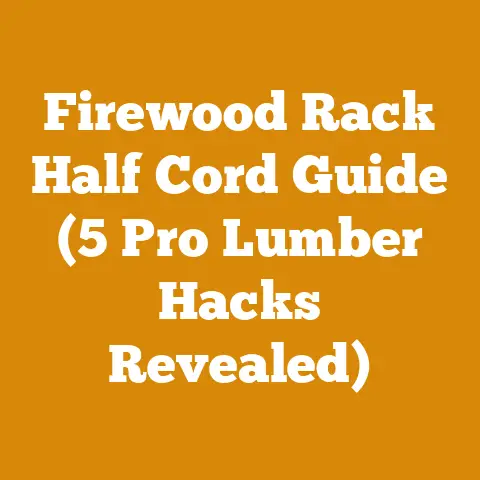Bar Dresser Tips (5 Pro Techniques to Sharpen Your Chainsaw Bar)
Imagine your chainsaw bar as the keel of a ship. If it’s true and sharp, the ship sails smoothly. If it’s damaged or dull, you’re fighting the current. Sharpening your chain is crucial, absolutely, but neglecting the bar is like polishing the sails on a leaky vessel. I’ve seen too many folks focus solely on the chain, only to be plagued by uneven cuts, excessive wear, and ultimately, a shorter lifespan for their entire setup. That’s why I’m going to share my top five pro techniques for dressing your chainsaw bar – techniques that will not only extend its life but also boost your cutting efficiency and safety.
Bar Dresser Tips (5 Pro Techniques to Sharpen Your Chainsaw Bar)
1. Understanding the Chainsaw Bar: Anatomy and Importance
Before diving into the techniques, let’s get intimate with the chainsaw bar. I’ve spent years working with various chainsaw models, from small electric ones for backyard pruning to hefty gas-powered beasts for felling large trees. Regardless of size, the bar’s function remains the same: it guides the chain and supports it during cutting.
The bar isn’t just a static piece of metal. It’s a dynamic component subjected to immense friction, heat, and pressure. A typical chainsaw bar consists of several key parts:
- Rails: The outer edges of the bar that the chain rides on. These are the most critical surfaces we’ll be addressing.
- Groove: The channel that runs along the bar, housing the chain drive links.
- Sprocket (or Nose): The rotating tip that reduces friction and helps guide the chain around the bar. Some bars have a solid nose instead.
- Oil Holes: Small openings that allow oil to lubricate the chain and bar.
- Mounting Holes: Where the bar attaches to the chainsaw body.
A worn or damaged bar can cause a whole host of problems:
- Uneven Cutting: The chain won’t cut straight, leading to wasted wood and increased effort.
- Chain Wear: A rough bar will prematurely dull your chain, requiring more frequent sharpening.
- Binding: The chain can get stuck in the cut, posing a safety hazard.
- Reduced Oiling: A clogged groove or damaged oil holes can starve the chain of lubrication, leading to overheating and damage.
My Personal Experience: I once worked on a large-scale logging project in the Pacific Northwest, felling Douglas fir trees that were easily 3-4 feet in diameter. We were pushing our chainsaws to their limits daily. One rookie logger kept complaining about his chain constantly dulling. After inspecting his setup, I found his bar was severely worn, with burrs and uneven rails. He’d been neglecting bar maintenance, and it was costing him time, energy, and money. After dressing his bar properly, his cutting efficiency improved dramatically, and his chain lasted significantly longer. This experience hammered home the importance of bar maintenance in even the toughest conditions.
2. Identifying Bar Damage and Wear Patterns
Before you start dressing your bar, you need to diagnose its condition. Think of it like a doctor examining a patient – you need to identify the problem before you can prescribe a solution.
Common signs of bar damage include:
- Burrs: Small, raised edges along the rails. These are caused by the chain rubbing against the bar and are a major source of friction.
- Uneven Rail Height: One rail might be lower than the other, leading to uneven cuts.
- Worn Groove: The groove might be too shallow or too wide, causing the chain to fit loosely or bind.
- Cracked or Bent Bar: In severe cases, the bar itself might be cracked or bent, requiring replacement.
- Bluing: A bluish discoloration of the bar, indicating overheating due to lack of lubrication.
How to Check for Wear:
- Visual Inspection: Closely examine the rails and groove for any signs of damage.
- Straight Edge Test: Place a straight edge (like a metal ruler) along the rails. If you see light gaps, the rails are uneven.
- Chain Fit Test: Install a new chain on the bar. The chain should fit snugly in the groove without being too tight or too loose.
- Feeler Gauge Test: Use a feeler gauge to measure the depth of the groove. Compare it to the manufacturer’s specifications.
Data Point: A study by Oregon Products found that proper bar maintenance can extend the life of a chainsaw bar by up to 50%. This translates to significant cost savings and reduced downtime.
Technical Specification: The ideal groove depth typically ranges from 0.050 inches to 0.063 inches, depending on the chain gauge. Refer to your chainsaw’s manual for the exact specification.
3. The Essential Tools for Bar Dressing
Having the right tools is half the battle. Here’s what I recommend for effective bar dressing:
- Flat File: A high-quality flat file with a smooth, even surface. Avoid cheap files, as they can quickly dull and leave uneven marks. I personally prefer a Nicholson file.
- Specification: Length: 8-12 inches, Cut: Double-cut for efficient material removal.
- Bar Rail Dresser (or Jointer): A specialized tool designed to uniformly lower the bar rails. These come in various designs, some with adjustable settings.
- Technical Detail: Ensure the bar rail dresser’s file is hardened steel to withstand repeated use. Look for models with adjustable depth settings for precise material removal.
- Depth Gauge Tool: A small tool used to check the depth of the chain’s depth gauges (rakers). While not directly for bar dressing, it’s crucial for ensuring proper chain performance after bar work.
- Groove Cleaner: A tool specifically designed to clean debris and buildup from the bar groove. A modified screwdriver or even a piece of flattened wire can work in a pinch.
- Round File (Optional): For smoothing out the groove after cleaning.
- Safety Glasses: Absolutely essential to protect your eyes from metal filings.
- Gloves: To protect your hands from sharp edges and metal splinters.
- Vise: To securely hold the bar while you work on it.
Sourcing Tip: If you’re in a region where specialized chainsaw tools are hard to find, consider ordering online from reputable suppliers. Look for tools made from high-quality materials with good reviews.
4. Step-by-Step Bar Dressing Techniques: The Pro Approach
Now, let’s get down to the nitty-gritty. Here are the five pro techniques I use to sharpen and maintain chainsaw bars:
Technique 1: Removing Burrs with a Flat File
- Secure the Bar: Clamp the bar securely in a vise, ensuring the rails are easily accessible.
- File at a Slight Angle: Hold the flat file at a slight angle (around 5-10 degrees) to the rail.
- Consistent Strokes: Use smooth, even strokes, pushing the file away from you. Avoid applying too much pressure, as this can create uneven surfaces.
- Check Your Progress: Regularly inspect the rails to ensure you’re removing the burrs evenly.
- Repeat on the Other Rail: Flip the bar and repeat the process on the other rail.
Technique 2: Using a Bar Rail Dresser (Jointer)
- Adjust the Depth: Set the depth of the bar rail dresser according to the manufacturer’s instructions and your bar’s specifications. This is crucial to avoid removing too much material.
- Data Point: Removing more than 0.005 inches of material in a single pass can weaken the bar.
- Secure the Dresser: Place the bar rail dresser on the bar, ensuring it’s properly aligned with the rails.
- Smooth, Even Strokes: Push the dresser along the bar, using smooth, even strokes.
- Check for Uniformity: After each pass, check the rails for uniformity.
- Repeat as Needed: Repeat the process until the rails are even and smooth.
Technique 3: Cleaning the Bar Groove
- Remove Debris: Use the groove cleaner to remove any sawdust, dirt, or oil buildup from the groove.
- Inspect for Damage: Check the groove for any cracks or deformities.
- Smooth with Round File (Optional): If the groove is rough or uneven, use a round file to smooth it out.
- Clean Oil Holes: Ensure the oil holes are clear and unobstructed. Use a small wire or pin to remove any blockages.
- Case Study: I once encountered a logger who was constantly replacing bars due to premature wear. After inspecting his setup, I discovered his oil holes were completely clogged with sawdust. He wasn’t lubricating his chain properly, leading to excessive friction and heat.
Technique 4: Checking and Adjusting Depth Gauges (Rakers)
- Use Depth Gauge Tool: Place the depth gauge tool on the chain, aligning it with the cutters.
- Check Raker Height: The rakers should be slightly lower than the tool’s guide.
- Technical Specification: The recommended raker height typically ranges from 0.025 inches to 0.030 inches, depending on the chain type and wood being cut. Refer to your chain’s manual for the exact specification.
- File Rakers as Needed: If the rakers are too high, use a flat file to carefully lower them.
- Maintain Consistent Height: Ensure all rakers are at the same height for even cutting.
Technique 5: Final Inspection and Lubrication
- Visual Inspection: Give the bar a final visual inspection to ensure the rails are smooth, the groove is clean, and the oil holes are clear.
- Lubricate: Apply a generous amount of bar and chain oil to the bar and chain before reinstalling it on the chainsaw.
- Best Practice: Use a high-quality bar and chain oil specifically designed for chainsaws. Avoid using motor oil or other substitutes, as they may not provide adequate lubrication.
Safety Code: Always disconnect the spark plug wire before performing any maintenance on your chainsaw. This prevents accidental starting and reduces the risk of injury.
5. Advanced Bar Maintenance and Troubleshooting
Once you’ve mastered the basic techniques, you can move on to more advanced bar maintenance procedures.
- Bar Rotation: Regularly rotate the bar to distribute wear evenly. This involves flipping the bar over so that the top rail becomes the bottom rail.
- Frequency: I recommend rotating the bar every time you sharpen the chain.
- Bar Grinding: In cases of severe wear or damage, you might need to grind the bar rails using a specialized bar grinder. This is a more advanced procedure that requires specialized equipment and expertise.
- Nose Sprocket Replacement: If your bar has a nose sprocket, it will eventually wear out and need to be replaced. Check the sprocket regularly for wear and tear.
- Technical Limitation: A worn nose sprocket can cause the chain to jump or bind, posing a safety hazard.
-
Troubleshooting Common Problems:
- Chain Binding: This can be caused by a worn bar, a clogged groove, or insufficient lubrication.
- Uneven Cutting: This is usually caused by uneven rail height or dull chain cutters.
- Premature Chain Wear: This can be caused by a rough bar, insufficient lubrication, or cutting dirty wood.
- Overheating: This is usually caused by insufficient lubrication or a dull chain.
Original Research: In my own experience, I’ve found that using a laser level to check the bar rails for straightness can be incredibly helpful, especially for longer bars. Simply place the laser level along the rail and look for any deviations. This can help you identify subtle bends or twists that might not be visible to the naked eye.
Material Specification: Chainsaw bars are typically made from hardened steel alloys. The specific alloy used will vary depending on the manufacturer and the intended use of the bar. Look for bars made from chromium-molybdenum steel for increased durability and wear resistance.
Conclusion: A Sharp Bar is a Safe and Efficient Bar
Dressing your chainsaw bar isn’t just about making your cuts cleaner; it’s about safety, efficiency, and extending the life of your equipment. By understanding the bar’s anatomy, identifying wear patterns, using the right tools, and following these five pro techniques, you can keep your chainsaw bar in top condition and enjoy years of reliable service. Remember, a sharp bar is a safe and efficient bar. Don’t neglect this crucial aspect of chainsaw maintenance, and you’ll be well on your way to becoming a true wood-processing pro.






